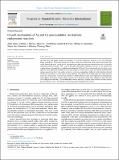Growth mechanisms of Ag and Cu nanodendrites via Galvanic replacement reactions
Abstract
Dendritic silver and copper crystals were produced via Galvanic replacement reactions on zinc and aluminum plates, respectively. The growth orientations of these metals were determined using electron microscopy. The results showed that a fast crystal growth associated with a high concentration of metal cations led to kinetically controlled growth along the <112> axes of the cubic close-packed structures. However, a slow growth rate resulted in thermodynamically controlled growth along the [111] axis. The crystal growth was not found to rely upon the direct deposition of metal cations at crystallographic sites on crystal facets, but instead, hydrated metal cations deposited on the crystal surface to form an amorphous coating layer, followed by the reduction of metal cations and crystallization at the crystal/coating interface. Twin defects and stacking faults were often observed across the whole particle and commonly observed ⅓{422} diffraction spots were explained by stacking faults rather than by the possible presence of any superstructures. The present work offers evidences to claim that both the crystal growth rate and Coulomb interaction between negatively charged crystal surface and metal cations play an important role in the formation of metal dendrites in replacement reactions.
Citation
Chen , J , Davies , J J , Goodfellow , A S , Hall , S M D , Lancaster , H G , Liu , X , Rhodes , C J & Zhou , W 2021 , ' Growth mechanisms of Ag and Cu nanodendrites via Galvanic replacement reactions ' , Progress in Natural Science: Materials International , vol. 31 , no. 1 , pp. 141-151 . https://doi.org/10.1016/j.pnsc.2020.12.007
Publication
Progress in Natural Science: Materials International
Status
Peer reviewed
ISSN
1002-0071Type
Journal article
Description
JLC thanks Chinese Scholarship Council and University of St Andrews for financial support.Collections
Items in the St Andrews Research Repository are protected by copyright, with all rights reserved, unless otherwise indicated.

